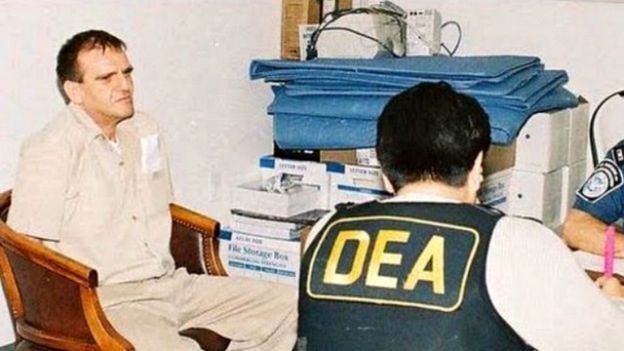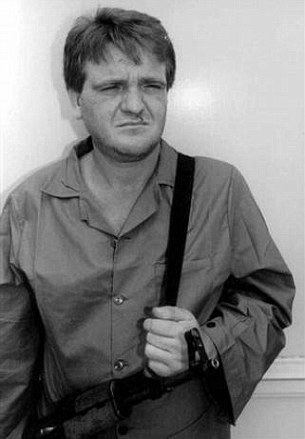Other names El Guero (Blondy) | Name Hector Palma | |
 | ||
Partner Miguel Angel Felix Gallardo, Joaquin Guzman | ||
Traslado de he ctor luis palma salazar el g ero palma al altiplano
Héctor Luis Palma Salazar (a.k.a.: "El Güero Palma") is a former Mexican drug trafficker and former leader of the Sinaloa Cartel alongside Joaquín "El Chapo" Guzmán. Palma was arrested on June 23, 1995 and deported to the United States, where he served a jail sentence until June 2016. He was then extradited back to Mexico in June 2016 where he was charged with a double murder in 1995 in Nayarit.
Contents
- Traslado de he ctor luis palma salazar el g ero palma al altiplano
- Mexico Arrest Drug Trafficker Hector Luis Salazar
- Early life and career
- First arrest
- Second arrest
- Kingpin Act sanction
- Corruption
- References

Mexico-Arrest Drug Trafficker Hector Luis Salazar
Early life and career

Jesus Héctor Luis Palma Salazar was born in Noria de Abajo, Mocorito, Sinaloa, Mexico in the mid 1940s. Palma began his life of crime as a car thief eventually working as a gunman for Miguel Ángel Félix Gallardo under the umbrella of the Guadalajara Cartel. Palma rose the ranks, and along with Eduardo "El Lobito" Retamoza and Gallardo, were leaders of the cartel. Following the loss of a large cocaine shipment, which was blamed on Retamoza and Palma, El Lobito was killed, and Palma was spared. Following Retamoza's death, Palma contacted and created an alliance with Joaquín "El Chapo" Guzman of the rival Sinaloa Cartel.

Palma splintered from the group which was handed down to Gallardo's nephews in Tijuana, who later formed the Tijuana Cartel (Arellano Félix Organization). Palma, along with a Venezuelan trafficker named Rafael Enrique Clavel, one time boyfriend of his sister Minerva Palma, began operating their own cartel.
First arrest

In 1978, Palma was arrested in Arizona on drug trafficking and sentenced to eight years in a U.S. prison. Upon his release, Palma discovered his wife, Guadalupe Leija Serrano, had run off with Clavel and taken their two kids. Clavel forced Guadalupe to withdraw $7 million USD from a bank account and later decapitated her, shipping her head back to Palma. The two children, Jesús and Nataly, were taken to Venezuela and dropped off a bridge named Puente de la Concordia, on the border with Colombia. Clavel soon afterward went to work for Gallardo in the Tijuana Cartel. In retaliation, Palma executed Gallardo's lawyer and Clavel's three children.
Palma returned to trafficking, this time within the Sinaloa Cartel, sharing leadership with Adrián Gómez González and Joaquín Guzmán Loera (El Chapo).
Second arrest
Palma was arrested in June 23, 1995, after a 12-seat Lear jet he was flying on to attend a wedding party crash-landed. Palma was traveling from Ciudad Obregón, Sonora to Guadalajara, Jalisco for a wedding ceremony when the jet was diverted and unable to locate a new landing strip in time. Palma survived the crash-landing and was later arrested by Mexican military officers; he originally evaded capture by traveling in full uniform as a Federal Judicial Police (PJF) officer complete with identification and an armed caravan of PJF personnel. The American judge that sentenced him to 9 years, gave him credit for time served in Mexican prisons.
After nine years in a maximum-security prison, Palma was then extradited back to Mexico in June 2016 where he was charged with a double murder of police officers in 1995 in Nayarit. He is currently held at the Altiplano Prison, near Mexico City.
Kingpin Act sanction
On 2 June 2003, the United States Department of the Treasury sanctioned Palma under the Foreign Narcotics Kingpin Designation Act (sometimes referred to simply as the "Kingpin Act"), for his involvement in drug trafficking along with six other international criminals and three entities. The act prohibited U.S. citizens and companies from doing any kind of business activity with him, and virtually froze all his assets in the U.S.
Corruption
Palma had managed to insert himself into the depths of the Mexican Federal Judicial Police (PJF), evading detection by posing as one in complete uniform, with identification, and traveling in a heavily armed caravan of PJF officers. It was later discovered he was able to evade capture by staying at the home of the local police commander.
The corruption within the police force has been documented to have spread to the judicial system. By bribing judges, the Sinaloa Cartel has evaded prosecution repeatedly. In 2004, 18 men were arrested in possession of 28 machine guns, 2 hand guns, 223 magazines, 10k rounds of ammunition, 12 grenade launchers, 18 hand grenades, smoke grenades, and bulletproof vests. The men were set free by Judge Jose Luis Gomez Martinez, who stated there was no evidence they were part of any criminal organization.
